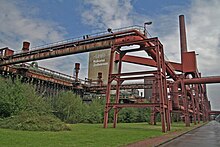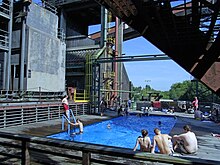Zollverein coking plant

The Zollverein coking plant in Essen was active from 1961 to 1993 and at that time was considered to be the most modern coking plant in Europe.
Today it is an architectural world heritage site and industrial monument . Together with the directly neighboring Zeche Zollverein , the former coking plant was declared a World Heritage Site by UNESCO in 2001 .
location
The Zollverein coking plant is located between the streets of Arendahls Wiese, Köln-Mindener Straße and Großwesterkamp in the northeastern Essen district of Stoppenberg . Immediately adjacent between the streets Arendahls Wiese, Fritz-Schupp-Allee, Gelsenkirchener Straße and Haldenstraße is the main area of the Zeche Zollverein with the systems shaft 12 and shaft 1/2/8. Today, the three systems are generally perceived as a total ensemble of the world cultural heritage.
history
The coking plant was built between 1957 and 1961 in connection with the Zollverein XII central shaft. The design of the coking plant was done by the industrial architect Fritz Schupp . On September 12, 1961, the first official furnace was pressed. In 1961 the coking plant had 192 coke ovens with a daily capacity of 5000 tons of coke. In 1973 the number of ovens was increased from 192 to 304 and the output increased to 8000 t of coke per day. In the meantime, up to 1100 people were employed. To produce 8000 t of coke, one needs 10500 t of coking coal (fat coal). The difference between 10,500 t and 8,000 t is the volatile components gas, tar, ammonia, hydrogen sulfide and benzene. The main product, coke , was used for smelting in iron and steel production. Up to 4 million cubic meters of coke oven gas were cleaned of tar, ammonia (NH 3 ), hydrogen sulfide and crude benzene every day . Some of the gas (45%) was burned to heat the ovens. The temperature there was 1350 ° C in order to maintain the temperatures of 1000 to 1100 ° C in the ovens. The remaining part (55%) of the gas was compressed to 8 bar and pushed into the Ruhr gas network. The by-products such as crude tar and crude benzene were sold to the chemical industry. Ammonia was converted into salt for agriculture. The hydrogen sulfide was processed into sulfuric acid.
Due to the steel crisis in the 1990s and the resulting fall in coke demand, the coking plant was shut down on June 30, 1993.
Since October 2006 the former control center of the coking plant has housed the Erwin L. Hahn Institute for Magnetic Resonance Imaging . This research facility of the University of Duisburg-Essen and the Radboud University of Nijmegen develops devices and processes for magnetic resonance tomography .
World Heritage
After the closure, the state of North Rhine-Westphalia took over the site from what was then Ruhrkohle AG . The plant was supposed to be sold to China, but the contract was not signed. The International Building Exhibition Emscher Park spoke out in favor of maintaining the coking plant.
The state finally placed the facility under a preservation order . The construction company Bauhütte Zeche Zollverein Schacht XII GmbH ended its renovation work at Zollverein in 1999. The development company Zollverein mbH (EGZ), founded in 2001, as well as the Zollverein Foundation and the Foundation for the Preservation of Industrial Monuments and Historical Culture were responsible for the further maintenance and use of the disused facilities. In the same year, the installation “Factory Swimming Pool” by the Frankfurt artists Dirk Paschke and Daniel Milohnic was inaugurated at the eastern end of the coking plant. During the summer holidays, the local population has the opportunity to swim free of charge in a 140 cubic meter swimming pool made from industrial containers.
On August 31, 2002, the Zollverein colliery and coking plant were added to the list of the world 's cultural and natural heritage . The Zollverein complex is also the anchor point of the European Route of Industrial Culture and a station on the Route of Industrial Culture . A cooperation agreement between the Zollverein Foundation and RAG Montan Immobilien GmbH is the basis for the further development of the location as part of the world cultural heritage.
The former mixing plant houses an information point and a café-restaurant. Further cultural and tourist offers are:
- the monument path in the coking plant (starts at the mixing plant);
- the “factory swimming pool ” by the Frankfurt artists Dirk Paschke and Daniel Milohnić , opened in 2001 as part of the contemporary art and criticism art project , consists of two overseas containers welded together, open from the beginning of July to mid-September;
- the sun wheel, a hubless ferris wheel with 14 gondolas that was opened in 1999 and rotates through the former coke oven battery 9, only open in summer on weekends. The sun gear has been closed since 2010. Whether it will go back into operation is not certain, as the authorities believe that it is not part of the original architecture, i.e. has nothing to do with the coke production process and is therefore not part of the monument protection scheme;
- the ice rink on the water-filled printing machine track, open from early December to early January;
- the room installation The Palace of Projects by the artist couple Ilya and Emilia Kabakov as a permanent exhibition in the salt warehouse.
literature
- Eitel Mantowski, Claudia Hellwig, Frank Münschke (eds.): The Koker on Zollverein. Zollverein-Koker talk about their work and life at the Zollverein coking plant. Klartext-Verlag, Essen 2012, ISBN 978-3-8375-0690-7 .
- Heike Oevermann: About dealing with the industrial heritage. A discourse-analytical study of urban transformation processes using the example of the Zollverein colliery. Klartext-Verlag, Essen 2012, ISBN 978-3-8375-0834-5 .
- Dietmar Osses: coal, coke, culture. The coking plants of the Zollverein colliery. Foundation for the preservation of industrial monuments and culture of history, Dortmund 2002, ISBN 3-935783-09-4 .
- Zollverein Foundation: Zollverein World Heritage Site. Past and present of the coking plant and Zeche Zollverein (German / English), Klartext Verlag , Essen 2008, ISBN 978-3-89861-844-1 .
- Rolf Tiggemann: Zollverein Schacht XII , Klartext Verlag, Essen 2007, ISBN 978-3898617413 .
Web links
- Zollverein website with a map of the complete Zollverein World Heritage Site (PDF file; 697 kB)
- UNESCO world cultural heritage
- Industrial monument foundation for the Zollverein coking plant
- Industriedenkmal.de to the Zollverein coking plant
- Ruhrtriennale: Zollverein coking plant
- Description of this sight on the route of industrial culture
Coordinates: 51 ° 29 ′ 20 ″ N , 7 ° 2 ′ 4 ″ E









